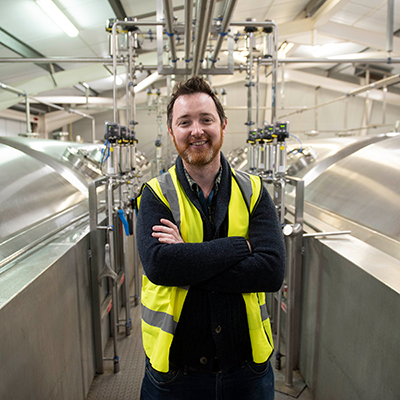The brewery still operates out of its original site at the heart of Southwold, and produces the equivalent of 1,900 barrels of beer a day. However, fit-ting a 21st century brewery into a 19th century building has proved to be an on-going challenge for Fergus and his team, as they have looked to keep pace with modern brewing methods and rapidly expanding consumer demands for a much wider portfolio of beers and spirits.
One area where the brewery has looked to take serious strides forward is the introduction of automation; and more specifically, the use of robotic end-of-line palletising systems to process the beer barrels once they have been filled.
Fergus continues: “While we’ve expanded our portfolio in recent years, cask beer very much remains a core part of the brewery. At the end of our main cask filling line – where we put the beer into the barrels – we had an old palletiser, which took up a lot of space. Given where the brewery is located, we’ve got a very limited amount of space, so we have to be quite creative when it comes to using it as effectively as possible.”
“We had identified a new piece of technology that we wanted to install to allow us to brew a 0.5%-alcohol version of our Ghost Ship Pale Ale, but we had exhausted all available floorspace. However, by upgrading the old palletiser to a more compact automated solution, we figured we could accommodate everything within the existing brewery site. We actioned this in early 2018 and approached FANUC to design a robotic end-of-line loading system.”
 In order to meet the significant load demands of handling metal barrels filled with over 160 litres of beer, FANUC specified its R-2000iC/210L 6-axis palletising robot. With a maximum payload of 210kg, it could comfortably process the full casks at the required rate of 250-300 barrels an hour, to keep pace with the beer as it came out of the filling line. With a compact footprint of 771mm x 610mm, and a reach of 3100mm, it can easily operate within the confined working environment of the brewery. Crucially, the robot body is IP54 rated, to protect it from the residual beer found throughout the cask filling line.
In order to meet the significant load demands of handling metal barrels filled with over 160 litres of beer, FANUC specified its R-2000iC/210L 6-axis palletising robot. With a maximum payload of 210kg, it could comfortably process the full casks at the required rate of 250-300 barrels an hour, to keep pace with the beer as it came out of the filling line. With a compact footprint of 771mm x 610mm, and a reach of 3100mm, it can easily operate within the confined working environment of the brewery. Crucially, the robot body is IP54 rated, to protect it from the residual beer found throughout the cask filling line.
However, the R-2000iC/210L was not Adnams’ first foray into robotics. Back in 2017, in response to the growing popularity of keg beers, Fergus and his team decided to expand Adnams’ keg programme. Up until then all non-cask beer was sent away for kegging, but the brewery wanted to bring that process in-house at its main site in central Southwold. This involved finding space for conditioning tanks, as well as filtration and kegging equipment. The final piece of the puzzle was the addition of a FANUC R-2000iC/165F robot within the kegger, which was used to lift and stack the newly filled kegs. While this was on a much smaller scale com-pared to the brewery’s cask line, its success paved the way for the much larger system, which followed on the cask filling line in 2018.
Following the finished installation of the R-2000iC/210L in 2018 and the FANUC R-2000iC/165F in 2017, all of the brewery’s cask and keg beers are now handled and loaded by robots.